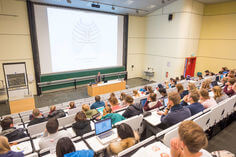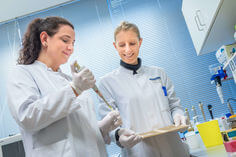Laborpraktika @ FuncNeuro
The department of Functional Neuroanatomy offers lab rotations for the following topics:
1. Whole-cell patch-clamp recordings
2. Viral gene transfer and stereotaxic delivery into the rodent brain, 3D immunohistochemistry, microscopy &
analysis
3. Olfactory discrimination behavior
4. dSTORM superresolution microscopy
5. In-vivo two-photon imaging
6. 3D scanning electron microscopy
More detailed descriptions are given below for each of the topics. Please note that several of the rotations are only offered for two students at a time. This strategy allows us to maximize the number of participants and minimize our efforts of supervision. Applying in tandem with a student fellow may increase your chances of obtaining an assignment.
The rotations can be done from 15.01. to 15.07. and 15.09. to 15.12. (rare exceptions may be possible on an individual basis).
Application procedure:
We make a fixed number of lab rotations slots available each year that are distributed on a first-come first-serve basis. For rotations covering 8 weeks special requirements apply (see below).
Please send your application to lindenberger(at)ana.uni-heidelberg.de and make sure to mention the following information:
- Which topic: mention maximally 2 choices in the order of preference
- What is your background: briefly mention why you want to do the practical and what your previous experience levels on the given topic are.
- When and how long: give exact dates or a time range within which a defined number of weeks should be placed. For practicals with dual occupancy mention a partner for the rotation if possible.
After receiving your request we will check for availability of a supervisor for the topic and get back to you ASAP.
Description of topics & suggested time frame:
1. Whole-cell patch-clamp recordings (4 wks, 2 participants required; 8 wks extended rotation on individual basis)
This rotation focuses on learning the basics of the patch-clamp technique, in particular performing whole-cell recordings from cultured neurons and acute brain slices. The rotation can be done in two flavours:
- Standard version focusing on cultured neurons, if progress allow, recordings from acute brain slices will be started (4 wks)
- Extended version starting with cultured neurons and subsequently focusing on acute brain slices (8 wks). This rotation requires previous experience with electrophysiology or can be arranged as a 4 wks extension of the standard version. A mini project could be carried out in this time frame.
Topics covered: theoretical basis, pulling pipettes, making internal solutions, visualization of cells, approach and formation of the giga-seal, breaking in and establishing whole-cell recording, compensations, controlling the amplifier, applying recording protocols, data analysis
2. Viral gene transfer and stereotaxic delivery into the rodent brain, 3D immunohistochemistry, microscopy & analysis (4 wks, 2 participants required)
This rotation introduces viral gene transfer as a highly versatile means to genetically manipulate cells and stereotaxic approaches of viral delivery into the rodent brain. If will cover theory on different viral systems, virus production in the cell culture lab, surgical procedures, anesthesia, stereotaxic methods, fabrication of injection capillaries, verification of the injection in perfusion-fixed brains using wide-field fluorescence microscopy.
This rotation also introduces procedures of immunohistochemistry of nervous tissue using fluorescence as a readout, wide-field fluorescence microscopy, confocal microscopy focusing on acquiring three-dimensional image stacks, data handling and analysis using FIJI, Amira and other tools.
This practical can also be combined with the other microscopy topics.
3. Olfactory discrimination behavior (6-8 weeks)
The emphasis of this topic is on learning the theory behind operant conditioning-based behavioral schemes, perform the behavioral scheme, acquire and analyze behavioral data. This practical could be combined with viral gene transfer and may involve a targeted genetic perturbation subsequently investigated with behavior.
4. dSTORM superresolution microscopy (4 wks, 2 participants required)
This topic introduces the theory of localization-based super-resolution microscopy (2D & 3D dSTORM), sample preparation, image acquisition in 2D and 3D, image reconstruction and analysis, and visualization of results. An extension of the 4 wks period by another 4-6 wks in-depth training including a mini project is possible on an individual basis.
5. In-vivo two-photon imaging (6-8 wks)
Two-photon microscopy as a highly efficient imaging method to study fluorescently labeled neurons in the living rodent brain will be introduced in this rotation. It will include theory of multi-photon imaging, surgical approaches including chronic window implantiation, image acquisition with the 2P microscope, 4D imaging (3D stacks over time), image processing and analysis, visualization of results.
6. 3D scanning electron microscopy (6-8 wks)
Novel methods of scanning-electron-microscopy are the focus of this rotation (see Horstmann et al 2012). Covered are theory, sample preparation, imaging with



